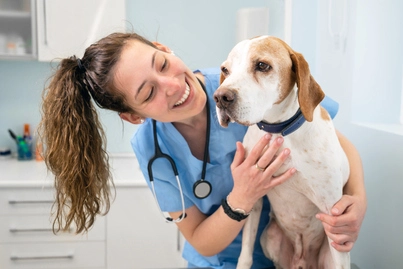Dogs communicate with people despite being unable to talk.

Their heads, ears, vocalizations, and even tails tell us a lot about how they’re feeling, provided we are willing to listen.
One thing most people understand about dogs is aggression.
Thanks to evolving alongside members of the canine family for generations, humans don’t need much time to interpret a snarl or growl.
It’s obvious:
So you know a growl means your dog is displeased by something, but how do you figure out why they growl?
What about when your dog growls when petted?
You need to take action:
Unwarranted aggression isn’t acceptable behavior, and getting to the root of it is vital to keeping the peace and harmony in the household.
You need to investigate the following:
There are a lot of reasons your dog might be growling at you.
Figuring out the cause is the first thing you must do to solve the problem.
The “Something Hurts” Growl
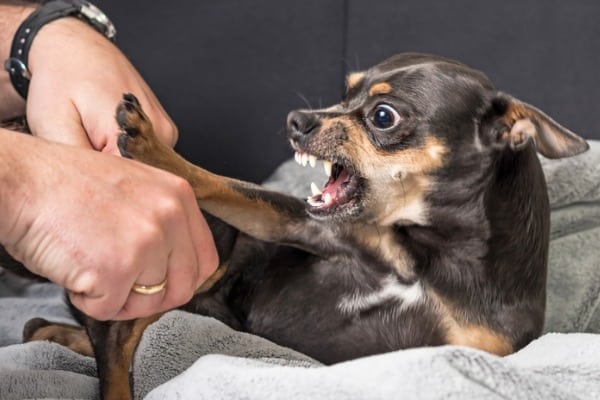
Why does my dog snap at me when being petted?
A dog who normally doesn’t growl or snarl and suddenly shows aggression at being touched is more than likely in pain.
They’re growling to tell you, “Hey, back off! That hurts!”
This is something seen frequently in old, arthritic dogs. Their joints become inflamed, swollen, and tender.
A normal petting session suddenly becomes irritating and aggravates their condition.
You might also notice your dog whimpers or cries when standing, lying down, or scaling the stairs.
What if your pet isn’t elderly?
If your dog has sustained an injury lately, you might be petting them where they’re bruised or otherwise hurt.
Be gentle:
The same goes for dogs who have had recent surgery – beware of petting them until they have fully healed.
If these things don’t apply to your dog, you should consider getting them checked out by a vet.
Connect with a verified veterinarian in minutes. No waiting for appointments or office hours. No high fees. Your pet's health made convenient and worry-free.
For one thing, just because you didn’t witness your dog being injured doesn’t mean they haven’t had a clumsy incident lately.
Your dog probably spends a lot of time at home alone, which brings plenty of opportunities for them to get bumps and bruises.
An outdoor, free-roaming dog could even be clipped by a car without you knowing it.
So if your dog is suddenly hesitant to let you pet them – to the point they growl at you to back off – a vet should check out what’s going on.
Similarly:
Some medical conditions cause pain, which, in turn, causes your dog to be uncharacteristically cranky and aggressive.
The sooner you find out why your dog is reacting to pain, the sooner they can be helped by medical treatments or pain medications.
It’s not only the humans in the house:
Dogs who are in pain due to injury or illness will likely lash out at other pets as well as people.
They won’t be interested in being touched, played with, and cuddled out of fear of being hurt further.
The “Go Away” Growl
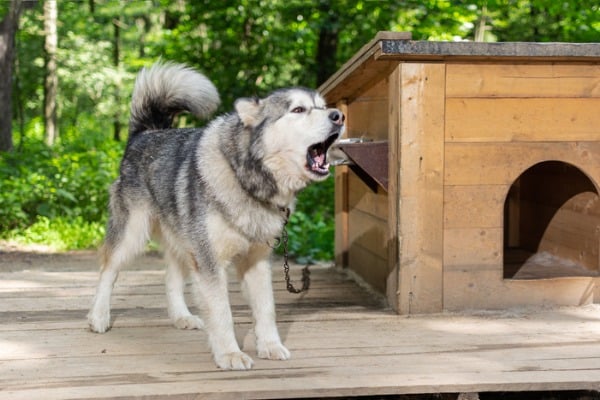
For a dog, their personal space and their bedding can be considered a resource.
Dogs resource guard for a number of reasons.
They could lack proper discipline; they could have a rough history where they had to defend things like food and beds.
Or perhaps, they’ve previously been mistreated. A dog remembers.
For example, if a man has been cruel to your pup in the past, you’ll notice behaviors like wanting to sleep next to a woman and not her husband.
Or worse, growl when her husband tries to be affectionate.
They can even try to guard things against you, which is why they will growl or snap when you invade their space.
It’s their way of telling you you’re not welcome to pet them or try to disturb them in their bed or other resting spots.
This is rarely a sudden development.
Some precursors to this behavior include growling at other dogs or pets when they get too close – which is why it’s important to curb that behavior before the dog goes pushing the line with humans.
Are some breeds more prone to this than others?
There’s no science-backed evidence that any breed has aggressive tendencies by default.
There is, however, some correlation between small dogs and lack of training.
A toy breed can attract humans who don’t fully appreciate the importance of training, even in small dogs.
Many people who want small dogs mistakenly believe that their small size – and option to simply pick them up when they act badly – is a substitute for proper training.
It’s not true.
As a result, a smaller breed dog might be more likely to resource guard – but this is due to their upbringing, not their genetics.
Some breeds, like pit bulls, have a bad reputation for being aggressive.
Similar to how small dog breeds can attract a certain type of people, pit bulls are the most common dog raised for fighting.
Because of this:
Many rescue pit bulls have a violent past, which can make them more prone to lashing out.
Behavior therapy is a must for any abused dog before trusting them with a new family.
Overall, your dog’s history matters more than their breed. Any breed has the potential to resource guard.
When your dog growls at you for petting him, they might also show their teeth and snap or lunge at you.
Other aggressive tendencies are usually present, such as growling if someone gets too near at mealtimes or aggressively protecting toys.
The video below demonstrates typical aggressive resource guarding.
You might have seen this video in a compilation of funny clips, but this scenario is far from amusing.
We can’t pretend to know this dog’s entire background or why they have behavior issues.
One thing we do know is that the dog in this video has been allowed to jealously guard their space in this instance, without any correction.
In a perfect world, this dog would have been curbed for this behavior.
Hitting or yelling doesn’t work.
However, removing them from their spot and showing them that aggression does not earn them the right to stay where they please speaks volumes to dogs.
If permitted to continue, this dog’s behavior has the potential to escalate into worse behaviors like snapping and biting.
It doesn’t help that it appears the dog was startled awake.
However, it is still not ideal for a dog to react aggressively, even if they’re startled.
If you ever find yourself in a similar scenario with your dog growling or snapping for petting them, take measures to correct their behavior.
The best way to send a message is to remove them from the spot they’re guarding immediately.
Place them in their crate – which is the only place in the house that belongs to them and no one else.
Or, put them in another room away from you and their spot.
This is the quickest way for your dog to understand that their aggression will not get them what they want, but the opposite.
Sometimes we absentmindedly reach over to pet our dogs while everyone is relaxing on the couch.
Odds are you’ve done it while they’re asleep, sometimes inadvertently.
You want a relationship with your dog where you can safely reach out and pet them without fear of them snapping or being startled, even if they’re in a deep sleep.
Watch how this sleeping dog reacts to someone in their space.
This dog and the majority of loved pets are completely fine with someone touching them and getting close – even during sleep.
Remember that desirable behavior like this is founded on a deep trust between humans and dogs.
Don’t be too hard on a dog if they come from a rough background.
You can’t expect them to fully trust you from day one if they were abused or mistreated in the past.
It takes time to build that relationship.
So if you have a rescue dog who growls when petted, be prepared to work with them to earn their trust and establish mutual respect.
No matter where your dog comes from, positive reinforcement is the most effective means to train them.
Hitting or shouting at them will never produce good results, but it is particularly detrimental to use corporal punishment on dogs who were already mistreated.
If your dog growls because they don’t want you in their space, you can say a firm “no!”.
Coupled with relocating them to a time-out spot, this will help them understand that they don’t make the rules about what you can and cannot do.
Dogs need personal space:
Just because you have trained your dog not to growl when you pet them doesn’t mean you should constantly test their limits or harass them needlessly.
The idea is that you should be able to pet or move them at any time if you want or need to, without fear of being growled at.
Don’t bug them for no reason or pet them incessantly if they clearly aren’t into it.
For example:
A dog who is avoiding confrontation will get up and walk away if they aren’t interested in being petted at the moment.
Don’t follow them and continue the contact – you’re setting them up to resource guard their personal space.
This is a crucial lesson to teach any children in the house.
If the dog leaves or tries to escape the situation, it’s time to leave the dog alone.
Don’t allow a child to chase a dog around the house when the dog wants to be left alone.
Dogs should not be permitted to snap if they’re being petted, but they also have a right not to be petted if they’re not in the mood.
Some parents need to be reminded that their children aren’t always as gentle as they think they are.
A dog growling when being petted needs to be corrected, of course.
However, if the dog growls because they’re being punched by toddler fists or their hair is being pulled, the child is the one who needs to be corrected.
The Happy Growl
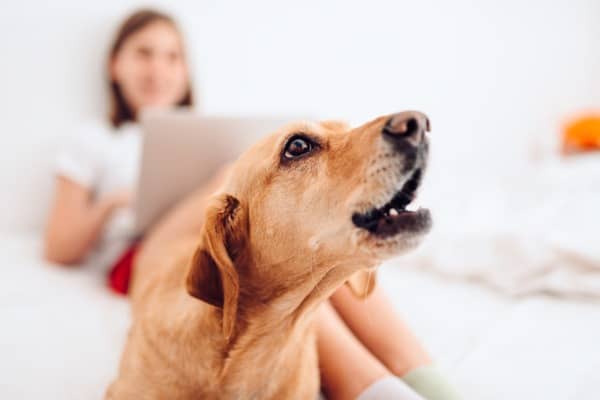
If you’re a new pet parent or don’t have experience with various dog sounds, you might mistake a growl for a happy vocalization.
Think of it like a cat purring.
A groaning, grunting sound can be in indicator your dog is actually happy.
If they do it while you’re petting them, they’re letting you know they like the attention, and the petting feels nice.
These sounds can be different in every dog, and sometimes it takes knowing the dog’s personality to distinguish aggressive growls from happy ones.
One way to tell the difference?
A dog who is aggressively growling will have body language to match their mood.
A good thing to look for is tension in their body – they will tense up and can assume a stance preparing to snap or lunge.
Are they suddenly scared of something in the house and is on guard and under stress?
This can feel like your dog has suddenly frozen the moment you touched them.
Dogs who make growl-like sounds because they’re happy and content will have body language which reflects that.
They should be relaxed – maybe even leaning on you or sitting in your lap.
They might wag their tail, lick you, or display other behaviors that relay the message that they’re happy.
If they sit behind you while you’re relaxing on the couch or suddenly start standing on you, pick up on these signs that something is a little off.
With the added growling, it’s time to start investigating.
Translating the Growl
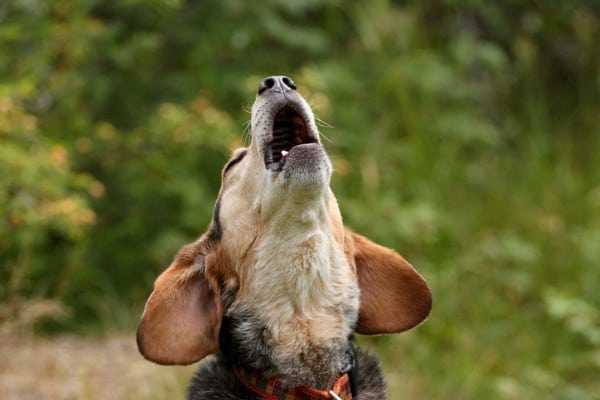
Why does my dog growl at me for no reason?
When it comes to dogs, there’s always a reason – it just takes some investigating to get to the bottom of it.
A dog might be in pain, which is something to have a vet help you get answers for.
Aggressive dogs might have had a tough time before they found you as a loving human.
Or, they might have simply been a little too spoiled in the past and require some extra discipline.
Not all growls indicate aggression, either.
Getting to know your dog will help make it easier to understand the meaning of their vocalizations.

